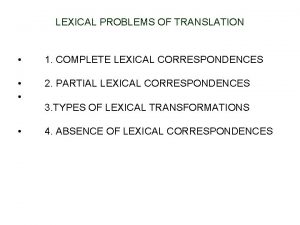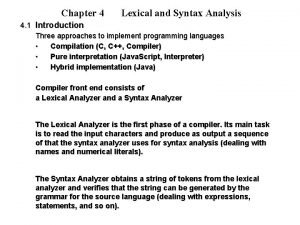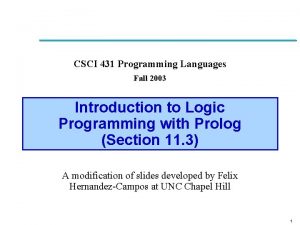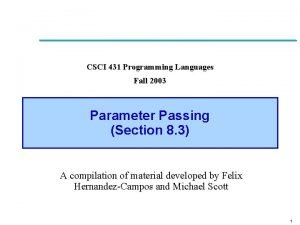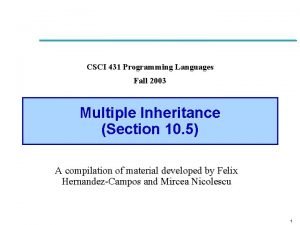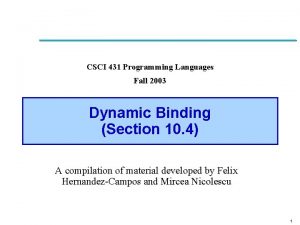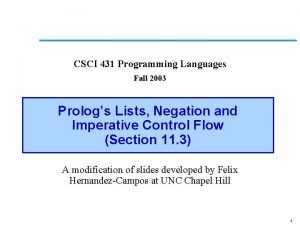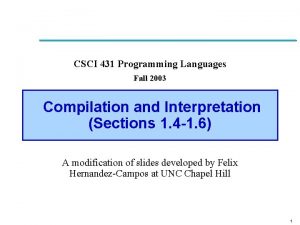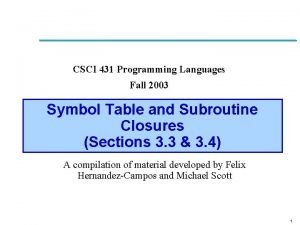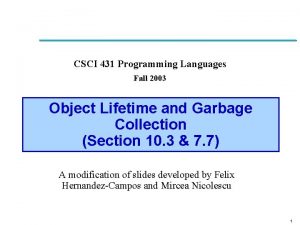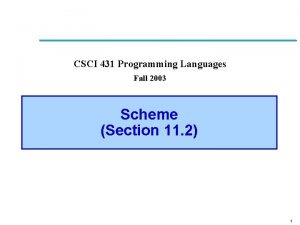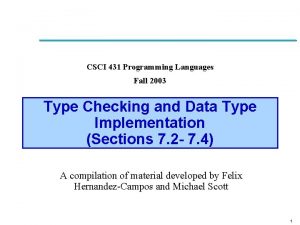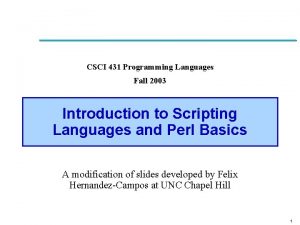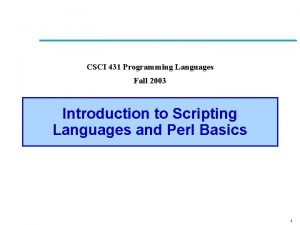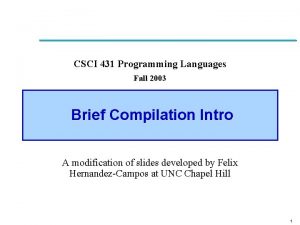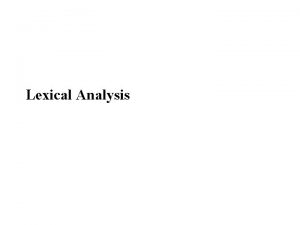CSCI 431 Programming Languages Fall 2003 Lexical Analysis










![Difficulties • Keywords and variable names • Look-ahead – Pascal’s ranges [1. . 10] Difficulties • Keywords and variable names • Look-ahead – Pascal’s ranges [1. . 10]](https://slidetodoc.com/presentation_image_h/cb5a799784b5899282573ec9049959e0/image-11.jpg)




- Slides: 15

CSCI 431 Programming Languages Fall 2003 Lexical Analysis (Sections 2. 1. 2 -2. 1. 3) A modification of slides developed by Felix Hernandez-Campos at UNC Chapel Hill 1

Phases of Compilation 2

Specification of Programming Languages • PLs require precise definitions (i. e. no ambiguity) – Language form (Syntax) – Language meaning (Semantics) • Consequently, PLs are specified using formal notation: – Formal syntax » Tokens » Grammar – Formal semantics 3

Phases of Compilation 4

Scanner • Main task: identify tokens – Basic building blocks of programs – E. g. keywords, identifiers, numbers, punctuation marks • Other tasks: remove comments, deal with pragmas, save source locations • Desk calculator language example: read A sum : = A + 3. 45 e-3 write sum / 2 5

Formal definition of tokens • A set of tokens is a set of strings over an alphabet – {read, write, +, -, *, /, : =, 1, 2, …, 10, …, 3. 45 e-3, …} • A set of tokens is a regular set that can be defined by comprehension using a regular expression • For every regular set, there is a deterministic finite automaton (DFA) that can recognize it – i. e. determine whether a string belongs to the set or not – Scanners extract tokens from source code in the same way DFAs determine membership 6

Regular Expressions • A regular expression (RE) is: – A single character – The empty string, – The concatenation of two regular expressions » Notation: RE 1 RE 2 (i. e. RE 1 followed by RE 2) – The union of two regular expressions » Notation: RE 1 | RE 2 – The closure of a regular expression » » » Notation: RE* * is known as the Kleene star * represents the concatenation of 0 or more strings 7

Token Definition Example • Numeric literals in Pascal – Definition of the token unsigned_number digit 0 | 1 | 2 | 3 | 4 | 5 | 6 | 7 | 8 | 9 unsigned_integer digit* unsigned_number unsigned_integer ( (. unsigned_integer ) | ) ( ( e ( + | – | ) unsigned_integer ) | ) • Recursion is not allowed! • Notice the use of parentheses to avoid ambiguity 8

Scanning • Pascal scanner Pseudo-code 9

DFAs • Scanners are deterministic finite automata (DFAs) – With some hacks 10
![Difficulties Keywords and variable names Lookahead Pascals ranges 1 10 Difficulties • Keywords and variable names • Look-ahead – Pascal’s ranges [1. . 10]](https://slidetodoc.com/presentation_image_h/cb5a799784b5899282573ec9049959e0/image-11.jpg)
Difficulties • Keywords and variable names • Look-ahead – Pascal’s ranges [1. . 10] – FORTRAN’s example DO 5 I=1, 25 => Loop 25 times up to label 5 DO 5 I=1. 25 => Assign 1. 25 to DO 5 I » NASA’s Mariner 1 (apocryphal? ) • Pragmas: significant comments – Compiler options 11

• Outline of the Scanner 12

Scanner Generators • Scanners generators: – E. g. lex, flex – These programs take regular expressions as their input and return a program (i. e. a scanner) that can extract tokens from a stream of characters 13

• Table-driven scanner • Lexical errors 14

Scanners and String Processing • Scanning is a common task in programming – String processing – E. g. reading configuration files, processing log files, … • String. Tokenizer and Stream. Tokenizer in Java • Regular expressions in Perl and other scripting languages 15
 Lexical translation example
Lexical translation example Lex
Lex Four seasons korean movie
Four seasons korean movie Real-time systems and programming languages
Real-time systems and programming languages Cs 421 uiuc
Cs 421 uiuc Multithreading program in java
Multithreading program in java Programming languages levels
Programming languages levels Introduction to programming languages
Introduction to programming languages Plc coding language
Plc coding language Procedural programming languages
Procedural programming languages Comparative programming languages
Comparative programming languages Alternative programming languages
Alternative programming languages Types of programming languages
Types of programming languages Transmission programming languages
Transmission programming languages Cse 340 principles of programming languages
Cse 340 principles of programming languages Types of programming languages
Types of programming languages
